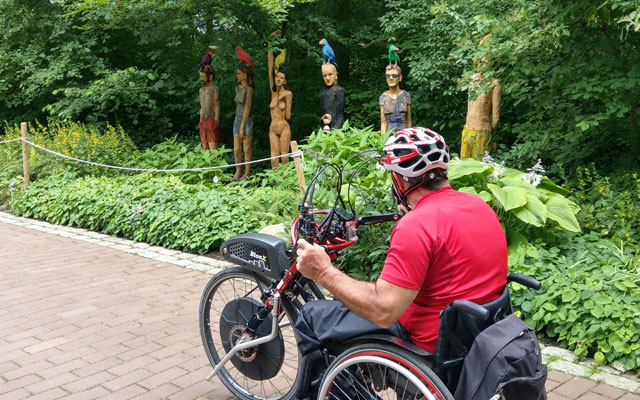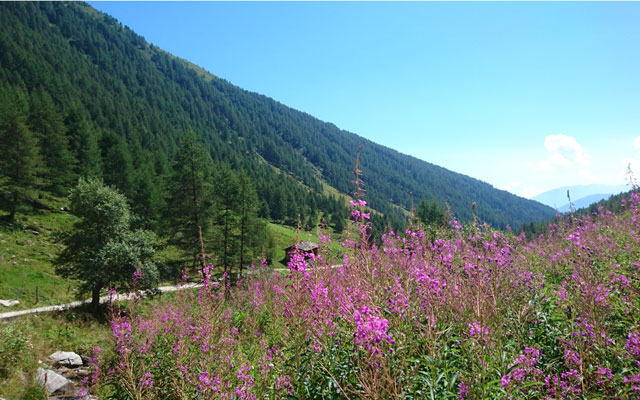pure nature
more Tourism in South Tyrol and its impact on hiking trails
Enjoying the view, breathing fresh air, being close and connected to nature - these are all things you can enjoy as a local as well as a tourist in the South Tyrolean Alps.
So it's no wonder that more and more people are drawn to the Alpine region.
Thus, activities such as Hiking, skiing or even cycling or mountain biking is becoming more and more popular.
That many would like to pursue these sports and not only at home, we can understand very well, because hiking, biking and skiing are also our great passions. Unfortunately, as a wheelchair user you can't do these activities only to a limited extent.
Especially for mountain bikers and downhill riders there are a lot of interesting routes in South Tyrol and many communities advertise with a high tourism budget annually for more bike tourism and more overnight stays in South Tyrol.
Although the information material on leisure activities for wheelchair users in South Tyrol has already improved thanks to the work of the online portal "South Tyrol for All", there is still far too little information on barrier-free sports activities. It is therefore not surprising that wheelchair users and people with other disabilities are given little consideration when planning tourist activities.
How else do you come up with the idea that we are about to report in this article.
We were astonished to read the news of the daily newspaper in the summer of 2019. Alto Adige and the South Tyrol News in which it is reported that hiking trails as well as trails which were often extensively used by mountain bikers should now be closed for the population on wheels. Also the new South Tyrolean daily newspaper reported on it.
For example, hiking trails that are supposed to be inaccessible to bikers have been blocked with logs and mounds of sand or dirt, and in some cases with loose brush or tree roots. This is to ensure that bikers no longer use these routes, which they have used despite the ban. According to the reports of the two news portals, this decision was taken by the municipal authorities together with the forestry authorities.
Of course it is understandable from our side that mountain bikers should be encouraged to use official cycle paths or designated tracks for downhill riding, but the whole thing is a bit short-sighted.
Because mountain bikers aren't the only ones on wheels!
In addition, such actions often lead to "imitators". Thus, some time later, in addition to the barriers in the Montiggl forest, fences were also installed on the Plose to prevent mountain bikers from riding these trails. At least according to one Report of the South Tyrol News. Of course, it is easy to open the gates, but it is hoped that this will have a deterrent effect.
Obstacles
How is a wheelchair user supposed to overcome such obstacles?
Find hiking trails that are suitable for wheelchair usersis not an easy undertaking either way. Often the paths are not specially marked, there are virtually no guidebooks and information about steep passages or steps on the trails are also rarely to be found.
Asking the locals for information often does not help either, as they are usually worried about giving wrong information and being responsible for problems that might occur later, such as an accident.
Sometimes it is quite helpful, when doing your own research on well passable hiking trails, to refer to the Findings of the Mountain Bikeor to fall back on the Experiences of parents with strollers.
Is it really meant that these should no longer "hike" the trails either?
In the case of the Montiggler Wald, these barriers have been installed above all in the areas that are considered so-called quiet zones and are intended to protect the protected area from further damage to the flora and fauna. These are not official hiking trails, but rather trails that have developed over time and have suggested to many hikers and mountain bikers that these are 'common hiking trails or shortcuts'. The barriers are intended to put a stop to this and to protect the flora and fauna as well as the landscape as a whole - as the newspapers reported at the time.
All of this, of course, we can understand and are in complete agreement with.
Free ride?
However, care must be taken that this does not become a 'free pass' to close off paths or hiking trails. Unfortunately, however, this is exactly what quickly happens afterwards. So it is not understandable for us, why hiking trails are closed off with gates and fences to keep mountain bikers away like it is a Report of the daily newspaper Alto Adige happened on the Plose.
That owners of properties on which official hiking trails run want to protect themselves against legal action by people who have had accidents is of course understandable. However, this cannot and should not lead to the fact that the paths are closed off with meter-high fences and gates and thus can no longer be used by wheelchair users. Rather, it is important to create a legal framework for the owners, so that they can only be prosecuted in certain, grossly negligent cases.
Another motive that is often cited is that pedestrians on a trail need to get to safety from the "Raudis on wheels". This may certainly be true in one place or another, but I don't believe that a pedestrian on a hiking trail needs to get to safety from a wheelchair user by, for example, jumping up the embankment or jumping into Lake Montiggl.
Even the wheels of a wheelchair - ok, they are often mountain bike profiles - are unlikely to destroy the local fauna. The ongoing construction boom is probably more responsible for that.
What is the situation in other countries?
The reports about the changes in South Tyrol are a bit older and at that time we were just wondering about them.
Now, however, we have become aware through a social media post that this approach is apparently not only interesting for the local authorities in South Tyrol. In other countries it is not necessarily cyclists, but rather moped riders or other wheeled vehicles with a certain speed - nevertheless, no one seems to think about wheelchair users here either.
So at the moment in New Zealand an innovation was hotly debated. Here - also through national committees - so-called Cycle Trail Gates (see photo). Analogous to the actions in South Tyrol, these are intended to prevent e.g. cyclists from using certain routes, or to slow them down somewhat. In New Zealand, the main focus is on motorised vehicles. A 'gate' is certainly one way to stop people from doing something specific, but certainly not the smartest and most sustainable.
After considerable protests from the various disability associations, some of these gates were dismantled again, while others were equipped with a key that can be used to open the barrier. This can be obtained from the respective municipality.
Why be simple when you can be complicated.
So much has already been done for accessibility and always and everywhere you meet hardworking people who continue to hold up the flag. But these are setbacks that one is reluctant to accept. Is it too much to ask people to think about the consequences before taking such actions, and not just consider those who can get around these barriers by other means? After all, when in doubt, a cyclist simply lifts his bike up and over - at least a sporty cyclist does.
But how is someone in a power wheelchair supposed to do that?
Sometimes it's just little things
Sometimes hiking trails have to be closed for various reasons. However, most hiking trails - especially in South Tyrol - are kept in good shape and, above all, are also aggressively advertised. So it's no wonder that more and more tourists come here to enjoy the Alps. But the tourists also include wheelchair users. And especially here, it is usually only a small thing to change on hiking trails to make them accessible for different types of wheelchairs. So there are enough paths that are super developed and only one small bottleneck or maybe 3 steps along the entire route. But these are exactly the reason why these paths are no longer accessible for wheelchair users. It would be very desirable if not so much attention is paid to the prohibition or blocking of trails for certain users, but rather to create the right offer for the different visitors or to make small adjustments to the existing offer to make it available to other user groups.
Of course, what must not suffer at all is nature. Because without the beautiful nature in South Tyrol and also elsewhere, we have no reason at all to practise our outdoor sports. It is therefore absolutely necessary to determine a suitable order in the planning of tourism and leisure activities. For us it is clear that nature comes first. After that, target group-orientedt and please:
Don't just forget a target audience just because it's small!
What do you think?
Have you ever had the same experience? You want to go on a great hike or try out the newly built bridge over a river nearby and right at the beginning there is an inexplicable obstacle? An obstacle that was actually not meant for you at all, but to keep an unwanted guest away? Doesn't that automatically make you feel unwanted?
We've had it happen to us, and often. Our response to this is, among other things, www.wheelchair-tours.org.
With our offer we try to make South Tyrol a bit more barrier-free - if only by providing information material about hiking trails without tree trunks, mounds of earth, meter-high fences or steps.


